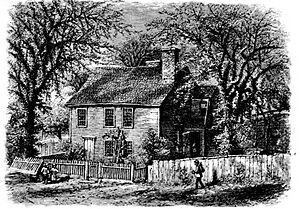North Burial Ground facts for kids
Quick facts for kids |
|
|
North Burial Ground
|
|
 |
|
| Lua error in Module:Location_map at line 420: attempt to index field 'wikibase' (a nil value). | |
| Location | Providence, Rhode Island |
|---|---|
| Built | 1700 |
| NRHP reference No. | 77000003 |
| Added to NRHP | September 13, 1977 |
The North Burial Ground is a large cemetery in Providence, Rhode Island. It covers about 110 acres (0.45 square kilometers). This cemetery opened in 1700 and was the first public burial ground in Providence. It is located north of downtown Providence, near North Main Street and Branch Avenue. It's one of the biggest city cemeteries in Southern New England. About 220 to 225 burials happen here each year.
History of the North Burial Ground
When Roger Williams founded Rhode Island in 1636, he made sure that government and churches were kept separate. This meant that Providence didn't have official church cemeteries like many other towns in New England. Instead, families usually buried their loved ones on their own farms.
In 1700, the town decided to create a public cemetery. This new cemetery would be open to everyone, no matter their religion or wealth. Even formerly enslaved people could be buried there. The town set aside 45 acres for this purpose. Ten acres were for the cemetery, and the rest was for a town common and a place for the local militia to train.
The first official burial at the North Burial Ground happened in 1711. A person named Samuel Whipple was buried there. For many years, only one or two burials took place each year. But by 1736, the number grew, with 14 people being buried that year.
By the mid-1800s, cemeteries started to change. People began to see them as beautiful parks where the public could relax outdoors. This idea was part of something called the "Rural Cemetery Movement." In Providence, the North Burial Ground was improved. More land was added, and curving roads and trees were planted. This made the grounds more attractive for people to visit and enjoy.
Famous People Buried Here
See also: Category:Burials at North Burying Ground (Providence)
Many important people from Rhode Island are buried at the North Burial Ground. These include governors, members of Congress, soldiers, wealthy individuals, formerly enslaved people, and writers. Here are some of them:
- Daniel Abbott: A leader in the Rhode Island colony government.
- Philip Allen: A Governor of Rhode Island and a U.S. Senator.
- Zachariah Allen: A well-known mill owner and community leader in Providence.
- William B. Avery: A soldier who received the Medal of Honor for his bravery.
- Edward Mitchell Bannister: A Canadian African-American painter.
- Chad Brown: An early pastor of the First Baptist Church in America. He was also an ancestor of the important Brown family.
- John Brown: A merchant and U.S. Representative. He was also one of the people who helped start Brown University.
- John Nicholas Brown II: A socialite and generous giver to good causes.
- Nicholas Brown, Jr.: A generous giver to good causes, and the person Brown University is named after.
- Kady Brownell: A woman who served as a nurse and flag bearer during the Civil War.
- Tristam Burgess: A U.S. Representative.
- Esek Hopkins: The only chief of the Continental Navy during the American Revolutionary War.
- Jonathan Chace: A U.S. Senator.
- John Hopkins Clark: A U.S. Senator.
- Nicholas Cooke: A governor of Rhode Island during the American Revolutionary War.
- Fred Corey: A Major League Baseball player.
- Charles Dow: A journalist who helped start Dow Jones & Company and The Wall Street Journal.
- Samuel Eddy: A U.S. Representative and Chief Justice of the Rhode Island Supreme Court.
- Arthur Fenner: A Governor of Rhode Island from 1790 to 1805.
- James Fenner: A U.S. Senator and Governor of Rhode Island for several terms.
- Sam Walter Foss: A librarian and poet.
- John Brown Francis: A governor and U.S. Senator.
- William Goddard (U.S. patriot/publisher): A printer during the American Revolutionary War.
- Stephen Hopkins: A colonial governor and one of the Founding Fathers who signed the Declaration of Independence.
- Jeremiah Brown Howell: A U.S. Senator.
- Richard Jackson: A U.S. Representative.
- Horace Mann: A famous educator, U.S. Representative, and the first president of Antioch College.
- James Manning: A delegate to the Confederation Congress.
- Albert Martin (soldier) (memorial): A soldier and the only Rhode Islander known to have fought at the Battle of the Alamo.
- Charles J. Martin: An artist and art teacher.
- James B. Mason: A U.S. Representative.
- Peter Mawney: A colonel in the Providence militia.
- Augustus S. Miller: Mayor of Providence from 1903 to 1905.
- Annie Smith Peck: A pioneering woman mountaineer.
- Saunders Pitman: A silversmith.
- Darius Sessions: A leader in the Rhode Island colony government.
- James F. Simmons: A U.S. Senator.
- Henry J. Steere: A generous giver to good causes and a manufacturer.
- Joseph L. Tillinghast: A U.S. Representative.
- Sarah Helen Whitman: A poet and essayist who was romantically linked to Edgar Allan Poe.
Images for kids
-
Dexter family monument with governor's flags for Gregory Dexter, colonial President
-
Grave monument for Governor Stephen Hopkins, signer of the Declaration of Independence
-
Grave plaque for Governor Stephen Hopkins
-
DAR grave plaque for Sarah Hopkins, wife of Governor Stephen Hopkins
-
Governor Nicholas Cooke grave monument
-
Nicholas Cooke governor's medallion
-
Grave of Capt. Pardon Sheldon, patriot involved in the Gaspee Affair















